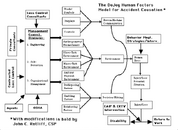Is it just me, but it sure seems there are a lot of fatalities for no more people that use rebreathers? I know they are used in a riskier environment but I know about two fatalities basically on the surface using them.
The surface is the riskiest place to be. Any issues with O2 delivery and the loop PO2 drops quickly. Buoyancy issues become much more challenging in shallow water as well, with an extra gas space to manage, especially as the CCR or the operator adds gas to the loop to maintain a setpoint.
They are much easier to dive in deeper water.





